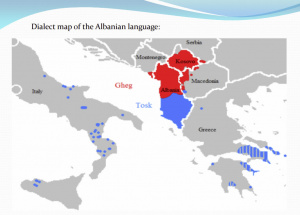Language/Tosk-albanian/Grammar/Definite-Articles
| ◀️ Verbs and Present Tense — Previous Lesson | Next Lesson — Personal Pronouns ▶️ |
Introduction[edit | edit source]
Welcome to the lesson on definite articles in Tosk Albanian! In this lesson, we will explore the importance of definite articles in the context of the Tosk Albanian language and understand their different forms. Definite articles are an essential part of any language and play a crucial role in communication. By the end of this lesson, you will have a solid understanding of how to use definite articles correctly in Tosk Albanian.
Understanding Definite Articles[edit | edit source]
Definite articles are used to specify a particular noun or noun phrase and indicate that the speaker is referring to a specific item or concept. In Tosk Albanian, definite articles are used differently based on the gender and number of the noun. There are several forms of definite articles that we will explore in detail.
Masculine Singular[edit | edit source]
When a noun is masculine and singular, the definite article "i" is used before the noun. Let's take a look at some examples:
| Tosk Albanian | Pronunciation | English |
|---|---|---|
| i djalë | ee dyah-luh | the boy |
| i mësues | ee meh-swehs | the teacher |
| i libër | ee lee-buhr | the book |
As you can see, the definite article "i" is placed before the masculine singular noun, allowing us to specify that we are referring to a specific boy, teacher, or book.
Feminine Singular[edit | edit source]
In the case of a feminine singular noun, the definite article "e" is used before the noun. Let's look at some examples:
| Tosk Albanian | Pronunciation | English |
|---|---|---|
| e vajzë | eh vahz | the girl |
| e mësuese | eh meh-sweh-seh | the female teacher |
| e shkollë | eh shkohl | the school |
In the examples above, the definite article "e" precedes the feminine singular noun, indicating that we are referring to a specific girl, female teacher, or school.
Neuter Singular[edit | edit source]
When a noun is neuter and singular, the definite article "e" is also used before the noun. Let's see some examples:
| Tosk Albanian | Pronunciation | English |
|---|---|---|
| e shtëpi | eh shteh-pee | the house |
| e qytet | eh chy-teht | the city |
| e libër | eh lee-buhr | the book |
In the given examples, the definite article "e" is used to indicate a specific house, city, or book.
Plural Nouns[edit | edit source]
When a noun is plural, regardless of gender, the definite article "të" is used before the noun. Let's explore some examples:
| Tosk Albanian | Pronunciation | English |
|---|---|---|
| të djemtë | tuh dyuhmtuh | the boys |
| të mësuesit | tuh meh-sweh-seet | the teachers |
| të librat | tuh lee-braht | the books |
As shown in the examples, the definite article "të" precedes the plural noun, indicating that we are referring to specific boys, teachers, or books.
Cultural Insights[edit | edit source]
The usage of definite articles in Tosk Albanian is influenced by regional variations and historical reasons. In certain regions, the pronunciation of definite articles may vary slightly, but the basic rules remain the same. It's fascinating to note that Tosk Albanian has preserved its definite articles from the ancient Albanian language, which can be traced back to the Illyrian period. This linguistic connection to the past adds depth and historical significance to the language.
In Albanian culture, definite articles play an important role in everyday communication. They help to clarify and specify the noun being referred to, which aids in effective communication. Understanding the correct usage of definite articles is not only crucial for language proficiency but also for cultural integration and appreciation.
Practice Exercises[edit | edit source]
Now, let's put our knowledge of definite articles into practice! Complete the following exercises by selecting the appropriate definite article for each noun.
Exercise 1: Choose the correct definite article for each noun.
- __________ djalë (the boy)
- __________ vajzë (the girl)
- __________ mësues (the teacher)
- __________ shkollë (the school)
- __________ shtëpi (the house)
Exercise 2: Select the correct definite article for each plural noun.
- __________ djemtë (the boys)
- __________ mësuesit (the teachers)
- __________ librat (the books)
- __________ qytetet (the cities)
- __________ vajzat (the girls)
Exercise Solutions[edit | edit source]
Exercise 1:
- __i__ djalë (the boy)
- __e__ vajzë (the girl)
- __i__ mësues (the teacher)
- __e__ shkollë (the school)
- __e__ shtëpi (the house)
Exercise 2:
- __të__ djemtë (the boys)
- __të__ mësuesit (the teachers)
- __të__ librat (the books)
- __të__ qytetet (the cities)
- __të__ vajzat (the girls)
Conclusion[edit | edit source]
Congratulations! You have successfully learned how to use definite articles in Tosk Albanian. Definite articles are essential for effective communication and understanding the specificity of nouns. By practicing and applying this knowledge, you will become more confident in your language skills. Keep up the great work and continue to explore the fascinating world of Tosk Albanian!
Other Lessons[edit | edit source]
- Questions
- Future Tense
- Give your Opinion
- To Be and To Have
- Adjectives and Nouns Agreement
- Adverbs of Manner
- How to Use Have
- Negation
- 0 to A1 Course
- Nouns
| ◀️ Verbs and Present Tense — Previous Lesson | Next Lesson — Personal Pronouns ▶️ |

